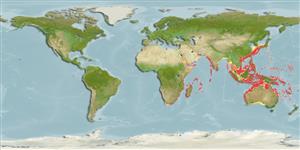Classification / Names
Common names from other countries
Main reference
Size / Weight / Age
Max length : 45.0 cm TL male/unsexed; (Ref. 9987); common length : 30.0 cm TL male/unsexed; (Ref. 9987); max. published weight: 110.00 g (Ref. 4883)
Length at first maturity
Lm 16.1, range 14 - 24.5 cm
Environment
Marine; benthopelagic; depth range 40 - 275 m (Ref. 12260)
Climate / Range
Tropical, preferred 28°C (Ref. 107945); 40°N - 36°S, 18°E - 172°E
Distribution
Short description
Dorsal
spines
(total): 9;
Dorsal
soft rays
(total): 28-31;
Anal
spines: 3;
Anal
soft rays: 25 - 28;
Vertebrae: 24. Lateral line curved below soft dorsal and with 30-44 strong scutes; color bluish green above, silvery below; caudal fin hyaline to yellowish; dorsal fins hyaline basally, light dusky distally. Opercle with small, black spot; opercular membrane with smooth margin. Snout longer than eye diameter; squarish lower posterior edge of maxilla; upper jaw with small teeth anteriorly; soft dorsal and anal fins relatively low, not falcate; pectoral fin sub falcate. (Other source of data on morphology: Refs. 3131, 3197, 3287).
IUCN Red List Status (Ref. 115185)
Threat to humans
Harmless
Human uses
Fisheries: highly commercial; bait: occasionally
Tools
Special reports
Download XML
Internet sources
Estimates of some properties based on models
Phylogenetic diversity index
PD50 = 0.5010 many relatives (e.g. carps) 0.5 - 2.0 few relatives (e.g. lungfishes)
Trophic Level
3.7 ±0.4 se; Based on diet studies.
Resilience
Medium, minimum population doubling time 1.4 - 4.4 years (K=0.2-1.4; Fec=20,000; tmax>3)
Vulnerability
Low vulnerability (24 of 100)
Price category
